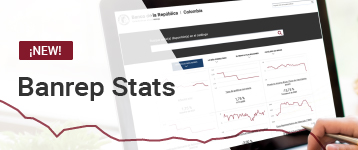Minutes of the Banco de la República Board of Director’s meeting on April 25, 2014
A regular meeting of the Board of Directors of Banco de la República was held in the city of Bogotá D.C. on April 25, 2014. In attendance were Mr. Mauricio Cárdenas Santamaría, Minister of Finance and Public Credit, Mr. José Darío Uribe Escobar, Governor and Managing Director of Banco de la República, and the Board Members Carlos Gustavo Cano Sanz, Ana Fernanda Maiguashca Olano, Adolfo Enrique Meisel Roca, César Vallejo Mejía and Juan Pablo Zárate Perdomo.
These minutes contain a summary of inflation, economic growth and their prospects for the future, which was prepared by the Bank’s technical staff (Section 1), in addition to a review of the key deliberations and policy options considered by the Board of Directors (Section 2).
1. INFLATION AND ECONOMIC GROWTH
a. Recent Developments in Inflation
In March 2014, annual consumer inflation rose again for the fourth month in a row. The amount reported by DANE was 2.51% which is 19 basis points (bp) higher than what was seen in February. So far this year, the CPI has accumulated an increase of 1.52% which is above what was registered for the same period in 2013 (0.95%). Just as in the previous two months, the upward pressures were mainly concentrated in the prices for food and regulated items although a slight rise in the basket of tradables was also seen.
In the basket for food, the annual change closed the month at 2.2%, 45 bp higher than in February. The surge occurred in the three main components of this basket: perishables (from 2.6% to 3.2% annually), processed foods (from 0.4% to 0.9% annually) and meals away from home (from 3.9% to 4.1% annually). In the case of the perishable food component, the prices are returning to normal after the low levels at the end of last year. The rises in the prices for processed food would be associated with the depreciation of the peso.
Within the CPI excluding food (2.6% annually, 9 bp more than last month), the main upward pressures came from the group of regulated items. This basket (2.2% annually) registered a rise of 45 bp in its annual variation compared to the previous month which was due to increases in the rates for natural gas. Respecting the CPI for electricity, a significant surge in the annual change was also seen, but in this case, it was mainly the result of a low base of comparison (these rates fell in March 2013).
The annual change in the CPI for tradables excluding food and regulated items (1.6%) showed an increase of 4 bp in comparison to the previous month. The rising trend in this basket is still related to the accumulated depreciation in the exchange rate. The annual change for non-tradables excluding food and regulated items (3.55%), in turn, was 6 bp lower than the month before. Note the annual change for rent (3.5%) which dipped slightly after the upticks seen for the previous two months.
The average for the four indicators of core inflation monitored by the Banco de la Republica was at 2.69% in March, 6 bp higher than the previous month and 19 bp higher than it was at the end of last year. Thus, there have been slight rises in that variable for a full period of five consecutive months.
The annual change in the PPI was upward for the fifth consecutive month and came to 2.6% compared to the 1.3% from the previous month. This is mainly explained by the greater adjustment in the local component (from 0.6% to 2.3% annually). The annual change in the imported PPI was a small uptick (from 4.28% to 4.34%). The depreciation of the peso, the increase in the prices for perishables and coffee explain this performance.
Inflation expectations continued their gradual rise. According to the monthly survey of financial market analysts done by the Banco de la Republica, the inflation expected for December of this year had climbed to 3.04% in comparison to the 2.90% from last month. There was a similar change in the expectations for 12 months from now which went from 3.0% to 3.1%. Regarding the expectations derived from the TES yield curve in the last four weeks (ending April 21) there was a rise in the horizons for the 2-, 3-, and 5-year securities which came very close to the long term inflation target.
b. Growth
The available information suggests that, in the first few months of 2014, economic activity has expanded at a rate similar to that registered towards the end of last year. Private consumption has grown at a favorable rate while investment, above all that related to transportation equipment and public works construction, has been more moderate. Note that the performance of the means of production has been influenced by a higher number of working days due to the fact that Easter week was in April (and not in March as it was in 2013). The facts that confirm the positive outlook for household consumption are: the Monthly Retail Sample Index (MMCM in Spanish) published by the National Bureau of Statistics (DANE in Spanish) which shows that sales grew 6.7% annually in February. This is one of the highest figures in the last 24 months. When vehicle sales were discounted, the increase was 4.6%. The performance of vehicle sales also suggests a positive result in expenditures for durable goods. However, in the first three months of the year, the consumer confidence index published by Fedesarrollo was, on average, below the figure for the fourth quarter of 2013. In spite of the preceding, this series was higher than the historical average since 2001. In line with this, the sales balance from the Banco de la Republica’s Monthly Survey of Economic Expectations (EMEE in Spanish) shows that the merchants saw a slightly higher demand in January and February than what was seen in the fourth quarter of 2013. Last of all, the favorable performance of the labor market, especially the higher growth of salaried employment as well as the fact that the financing of household consumption, in spite of the fact that it has slowed down slightly since the beginning of the year, also continues to grow at a positive pace are contributing to the favorable performance of this item.
With respect to investment, information is scarce. Based on the EMEE balance of investment expectations, gross capital formation excluding public works projects and construction will have remained dynamic for the first quarter of the year.
In February, the total exports registered a drop of 8.5% due to the combined fall of mining products (-10.3%) and industrial products and others (-15.1%). For the first group, the reduction was due to the lower foreign sales of crude oil (-12.2%), gold (-48%), and coal (-6.6%). In the second one, it was mainly because of the drop in vehicle exports (-67.5%). Exports of the main agricultural products, in turn, grew 34.4% as a whole (bananas 90.1%, coffee 20%, and flowers 31.8%).
In the area of supply, the indicators available for the first quarter of 2014 showed a mixed performance. Figures from sectors such as industry, energy, and commerce show favorable performance with respect to what was seen in the last quarter of 2013 while some indicators associated with branches of activity such as construction, mining, and agriculture reported some slowdowns.
Industry showed a positive but moderate expansion. The annual change in the IPI excluding coffee threshing was 2.8% for the month of February. In industry, the sectoral disparities continued. According to the Fedesarrollo survey of business owners’ opinions in March, the indicator for purchase orders and its trend continued rising slowly. The inventory indicator (counter-cyclical to production) rose a little but, it continued its downward trend. The expectations for production in three months stayed at acceptable levels and ones that were similar to those seen the month before. All of this points to a favorable performance this month. Industry’s demand for non-regulated energy continued growing quite dynamically in March (22.1% compared to 15.2% in February). It should be noted that part of this could be due to a low basis of comparison with the same month last year because of the Easter week effect.
For other sectors, the indicators that performed well were: demand for overall energy which grew 5.7% in March and 5.0% for the first quarter, cement production which rose at an annual rate of 10.2% in February and 6.1% in first two months, and coffee production which continued to expand at significant rates in the first three months of the year (29%). In the case of petroleum production, however, a significant slowdown was seen in the first quarter and, in March, the level of production fell below one million barrels per day. All of the above makes it possible to set the predicted range for the annual growth of the GDP between 4.2% and 5.4% for the first quarter of 2014. For all of 2014, the growth range for output remains between 3.3% and 5.3% with 4.3% being the most probable figure.
c. Financial Variables
Bank loans (N/C and F/C) registered an annual growth rate of 12.8% in March, which is slightly higher than the level seen in the previous month (12.4%). The loan portfolio in national currency showed an annual expansion rate of 13.5%, which is up slightly from that of last month (13.1%) while the one in foreign currency surged as it went from an annual growth rate of 2.0% to one of 2.5%.
Broken down by market, the portfolio of loans granted to households registered an annual growth of 12.9% in March, which is slightly lower than the growth seen the month before (13.3%). This was due to the performance of consumer loans, which moderated between February and March (from 11.6% to 11.3%). The growth rate for housing loans (16.2%), in turn, did not change over these two months. Regarding the commercial loan portfolio, the annual growth rate in March (12.8%) was higher than the rate for the previous month (12.0%). This was because of the upsurge in the national currency component (from 13.3% in February to 14.1% in March) and in the foreign currency component (from 1.7% to 2.3%).
The interest rates for the loans disbursed by credit institutions since the beginning of the cuts in the policy rate in July 2012 have accumulated reductions of -205 bp for mortgages, -221 bp for consumer loans, and -210 bp for construction loans.
The size of the decline in the real interest rates has been similar due to the fact that the recent rise in inflation has brought it closer to the July 2012 level. During this same period, the decline has been: -188 bp for mortgage loans, -203 bp for consumer loans, and -193 bp for construction loans.
The levels of real interest rates for consumer loans, mortgages, preferential loans, ordinary commercial ones and commercial lines of credit as well as loans for construction in September were below their historical averages as calculated since 2000. In contrast, the credit card loans are above their average.
d. Foreign Context
Economic activity continued to expand in the main developed countries during the first quarter of 2014. In the emerging countries, in turn, the growth rate continued to moderate.
In the United States, the extreme winter conditions in January and February affected economic activity. Nevertheless, recent information makes it evident that the economy is expanding at a favorable rate. Based on the March figures, industrial production and retail sales rallied in both annual and monthly terms. With respect to the labor market, the unemployment rate rose slightly over the last few months, however, the rate of job creation increased.
Economic activity in the euro zone, in turn, continues to recover at a modest rate. Based on the March figures, the opinion indicators in the manufacturing and service sectors remained in expansionary territory. At the same time, the confidence indices for business owners and consumers showed a positive trend again. Other indicators such as retail sales and industrial production also showed improvement.
In the case of the emerging economies, growth of the GDP in China slowed down during the first quarter of the year as it went from 7.7% to 7.4% annually. Exports and domestic demand grew less than they did during the previous period. This shows that the effect of the loss of strength in worldwide demand on the growth of the Chinese economy is not being offset by an expansion in their domestic market as many analysts expected. In Latin America, the indicators of productive activity continued to expand at a slower pace than in previous years. The low pace of growth in Brazil and the slowdown in the Chilean economy are especially notable.
Regarding international prices for commodities exported by Colombia, petroleum prices remained at favorable levels slightly below the average for 2013. Prices for coffee and nickel rose again last month. Prices for some imported food items, in turn, continued to rise.
With respect to inflation in the main developed economies, changes in prices remained low in Europe while in the United States, there was a slight rally although it stayed below the authorities’ target. In the case of Japan, the relaxation of monetary policy continues to be reflected in growing inflation.
With low inflationary pressure and growth that is below its potential, the main central banks have maintained an expansionary monetary posture. In the case of the United States Federal Reserve, the cutbacks in monthly purchases of assets remained in line with what was expected by the market and the first increase in the benchmark rate is expected to occur towards mid-2015. The long term rates have remained relatively stable.
In the case of the euro zone, in view of deflation fears, analysts predict that new monetary stimulus measures such as the purchase of financial assets will be implemented.
In the emerging economies, the inflationary panorama remains mixed as do the monetary policy responses. In Latin America, some countries have shown evidence of rises in prices. In the case of Brazil, the central bank increased their rates again while the central bank of Chile lowered theirs. In other countries in this region, interest rates have remained stable.
Since the beginning of the year, global risk aversion has moderated and the risk premiums in the main countries in this region have declined. This has been reflected in these emerging economies in the appreciation of the financial assets in local currency and in the appreciation of the currency with respect to the dollar. The preceding changes have been more accentuated in Colombia, especially in the public debt market as a result of the higher inflows of foreign capital. Foreign interest rates have not presented significant changes and remain at levels that are low but higher than the average seen in 2013.
To summarize, the above facts indicate that the average growth for Colombia’s trading partners in 2014 will be similar to what was registered in 2013 and that the terms of trade average is remaining at favorable levels. Expectations regarding the slow liquidity adjustment in the United States remain the same. Likewise, the expansionary monetary posture in other advanced economies is expected to persist for a lengthy period.
2. DISCUSSION AND POLICY OPTIONS
The Board of Directors took the following relevant aspects into consideration:
(i) Inflation and the average for the four measurements of core inflation continued to converge towards 3% in March. The inflation expectations, in turn, of economic analysts for a year from now as well as those that are implicit in public debt paper have fluctuated around the long term inflation target.
(ii) The macroeconomic forecast indicates that domestic demand will continue to grow at a favorable rate and that the economy will draw close to full use of its productive capacity in 2014. As the same time, the unemployment rate that is not seasonally adjusted has continued on a downward trend and reached the lowest level seen so far this century.
(iii) To the degree that inflation has been converging with the target of 3%, the different, real interest rates have dropped. In March, the growth of loans as a whole surged slightly driven by the performance of commercial loans and mortgages.
(iv) The risk premiums for various emerging economies have declined recently, financial assets in local currency have appreciated, and their currencies have also appreciated with respect to the dollar. The preceding changes have been more accentuated in Colombia, especially in the public debt market as a result of the higher inflows of foreign capital.
(v) The recent data on global economic activity suggest that the worldwide recovery will continue in 2014. In the United States, the latest numbers indicate that economic activity could maintain a gradual recovery while the expansion in the Euro zone will continue at a modest rate. The slowdown in some emerging economies may become more accentuated. With that, it is likely that the average growth for Colombia’s trading partners in 2014 will be similar to the rise registered in 2013 and that the average for the terms of trade will remain at high levels.
(vi) Expectations for a slow adjustment to the liquidity in the United States are staying the same. Likewise, the expansionary monetary posture in other advanced economies is expected to persist for a lengthy period. The foreign interest rates have not shown significant changes and remain at low levels although higher than the average seen in 2013.
The majority of the members of the Board thought that macroeconomic stability and the current convergence of inflation with the long term target would be compatible with a monetary policy posture that was a little less expansionary than the current one. They also thought that a gradual and timely adjustment of the latter would reduce the need for abrupt changes in the future and ensure macroeconomic stability. Considering all of this and the lags between actions taken based on monetary policy and their effect on inflation and growth, raising the benchmark interest rate 25 basis points was thought to be prudent.
One member of the Board expressed the need to keep the benchmark interest rate unaltered in consideration of the fact that inflation expectations are in perfect alignment with the target of 3% fixed by the Board of Directors of the Banco de la Republica. In addition, according to the Bank’s technical team, the most probable growth figure for 2014, 4.3%, implies that the output gap will remain in negative territory over the course of the year. These considerations suggest that the monetary policy posture should be kept unchanged until more information on the changes in economic activity in the first quarter of the year is available.
3. POLICY DECISION
The Board of Directors decided by majority vote that it would be appropriate to raise the benchmark interest rate by 25 bp and set it at 3.5%.
The Board will continue to monitor the performance and projections for economic activity and inflation in the country, the asset markets, and international situation carefully. Finally, they reiterate that the monetary policy will depend on the information available.














.png)

































